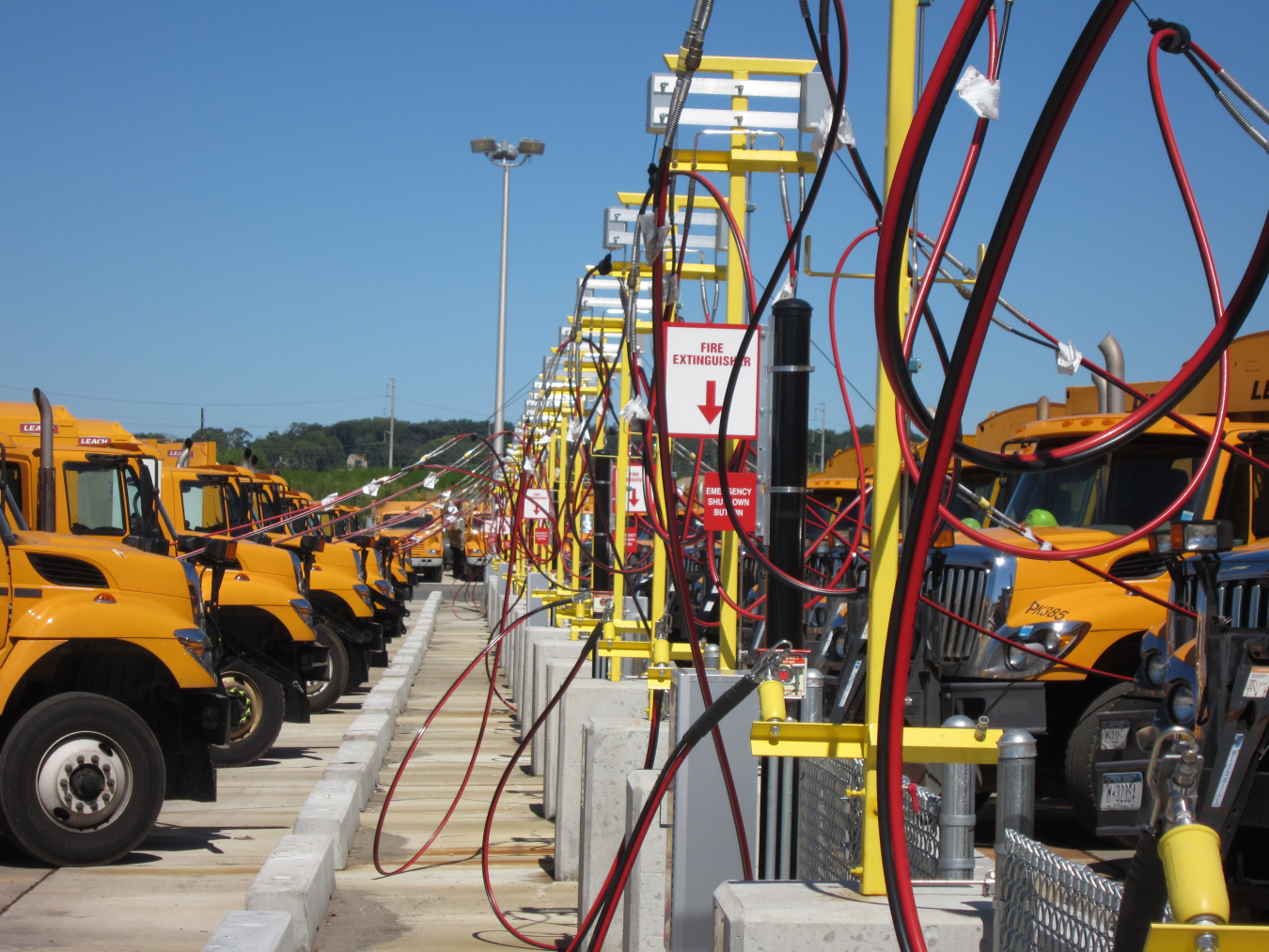
Refuse trucks in Oyster Bay, Long Island, filling up at a natural gas station. These trucks were part of a project supported by the Vehicle Technologies Office through Clean Cities.
Alternative fuels increase the number of options available to drivers, which reduces price volatility, supports domestic industries, and increases environmental sustainability. The Vehicle Technologies Office (VTO) supports research and development (R&D) to improve how vehicles can use these fuels in the future, as well as activities to increase their availability today. The DOE’s Alternative Fuels Data Center provides basic information on alternative fuels, including Biodiesel, Ethanol, Natural Gas, Propane, and Hydrogen. It also provides information on stations that sell alternative fuels and tax credits and other incentives for using alternative fuels.
The Vehicle Technologies Office's Contribution
VTO’s research considers how to better use fuels in today’s engines as well as how to combine alternative fuel blends with advanced combustion engines to reduce emissions and improve efficiency through the DOE national laboratories’ Co-Optimization of Fuels and Engines project.
VTO supports activities to:
- Research biofuels and their effects on combustion: Determine the impact of biofuels’ properties on engines’ efficiency, performance, and emissions. Activities include examining ways to increase alternative fuel vehicles’ fuel economy, investigating the potential effects of upcoming blends, and improving the quality of current and future biofuel blends.
- Research natural gas: Support the development of natural gas engines and renewable natural gas projects.
- Help regulated fleets use alternative fuels: Collaborate with fleets (mainly state and utility fleets) covered under the Energy Policy Act of 1992. Our sister office, the Federal Energy Management Program, works with federal fleets.
- Test alternative fuel vehicles: Collects on-road and laboratory data to better understand how alternative fuel vehicles function in a variety of conditions.
- Deploy alternative fuels: Work with nearly 100 local coalitions across the country to help fleets choose which alternative fuels will best meet their needs as well as prepare communities for increasing numbers of alternative fuel vehicles.
- Provide tools through the Alternative Fuels Data Center: The Laws and Incentive database, which includes information on state and federal tax credits; the Alternative Fueling Station Locator, which lists more 21,000 public and private stations across all alternative fuels; and the Alternative Fuel and Advanced Vehicle Search to look up light-, medium-, and heavy-duty alternative fuel vehicles.
Partnerships
To accomplish these goals, VTO collaborates with national laboratories, universities, industry, and community partners.
Research activities in alternative fuels work with:
- The U.S. Drive Partnership, an industry partnership focusing on light-duty vehicles
- The 21st Century Truck Partnership, an industry partnership to dramatically increase heavy-duty vehicle fuel economy while continuing emissions reduction.
- VTO’s Advanced Combustion Engine research, to look at the interaction between alternative fuels and advanced internal combustion engines
- The Bioenergy Office (which focuses on production of biofuels) and Hydrogen and Fuel Cells Program (which focuses on the use of hydrogen) to maximize collaboration and avoid duplication of effort
- The Environmental Protection Agency to provide data for certain rulemakings
Activities to increase the use of alternative fuel vehicles are carried out with a variety of partners:
- The National Clean Fleets Partnership works to reduce petroleum use in large commercial fleets
- The Clean Cities-National Parks Initiative works to reduce petroleum use and greenhouse gas emissions in transportation at the National Parks
Goals
The research activities in alternative fuels fall under the Fuel and Lubricant Technologies subprogram and are described in the Fuel & Lubricant Technologies Annual Report.
VTO’s major deployment goals for alternative fuels are:
- EPAct fleets: Have all covered vehicle fleets acquire alternative fuel vehicles or reduce petroleum use equal to purchasing 75 percent of their new vehicles as alternative fuel vehicles
- Clean Cities: Combined with other petroleum reduction strategies, reduce petroleum use in transportation in the United States by 2.5 billion gallons a year in 2025.
Alternative Fuels Successes
-
The trucks are part of a much larger Recovery Act project, which is expected to reduce 3.1 million GGE/year and 8,429 pounds of carbon dioxide per ...March 10, 2015
-
Oregon is planning for the large-scale deployment of hybrid and all-electric vehicles to reach the state's goal of 30,000 plug-in vehicles by 2015...March 10, 2015
-
Project FEVER (Fostering Electric Vehicle Expansion in the Rockies), funded by EERE’s Clean Cities plug-in electric vehicle community readiness a...August 7, 2014
-
With the support of $10.1 million from EERE (including funds from the American Recovery and Reinvestment Act), more than matched by $13.6 million f...June 5, 2014

